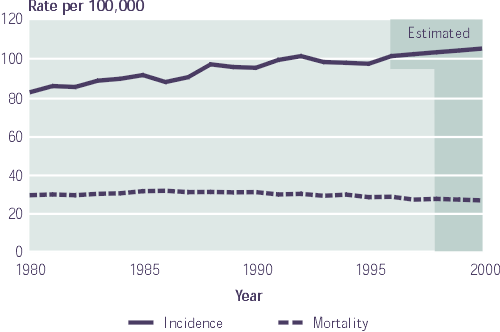Common menu bar links
Institutional links
Diseases & Conditions
Health & Safety
Research & Statistics
Agency Information
Search Box
E-mail this page
BACKGROUND
Breast cancer continues to be the most common cancer among Canadian women and the second highest cause of cancer death in women, with 19,200 new cases and 5,500 deaths estimated for 20001. A rise in the incidence of breast cancer has been observed over several decades paralleling an increase in mammographic screening. However, mortality rates have dropped, particularly since 1990, attributed, in part, to improved treatment and to early detection through mammography screening (Figure 1).
|
Figure 1 |
 |
|
Source: National Cancer Institute of Canada: Canadian Cancer
Statistics 2000, Toronto, Canada, 2000. |
Currently, there is insufficient knowledge about the causes of breast cancer for primary prevention strategies to reduce incidence in the population. Most known risk factors are not modifiable. Of the known risk factors, age has the strongest influence. Both the incidence and mortality of breast cancer rise sharply with age, with the highest rates among women aged 60 and over2. Nearly half of all new cases occur among women aged 50 to 691. It has been demonstrated, through randomized trials, that women in this age group benefit the most from breast screening. Delivery of regular, high quality breast screening to this group has the potential to reduce breast cancer mortality rates by approximately one third3,4.
|
Nearly half of all new breast cancer cases occur among women aged 50 to 69 and it has been demonstrated these women benefit the most from breast screening. |
[Previous] [Table of Contents] [Next]
